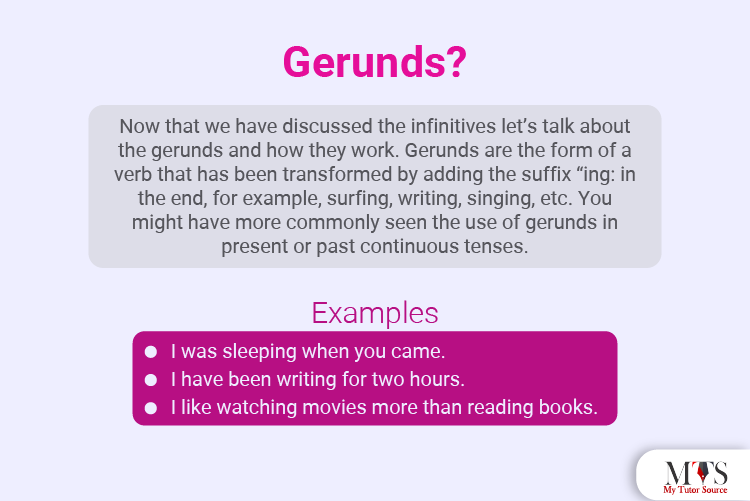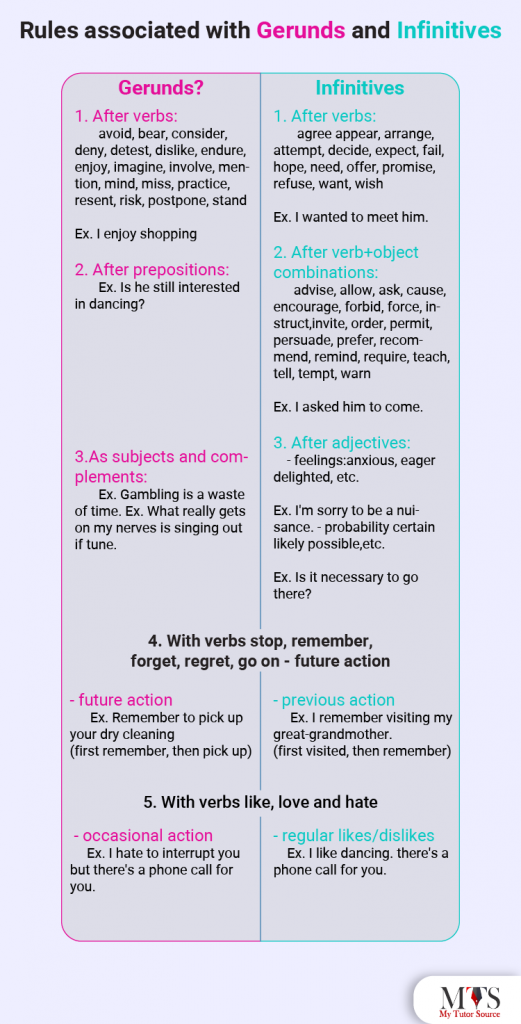

In the English language, you must have seen verbs used in different forms. Sometimes it is added in a sentence in its simplest form, while in other sentences, it is modified to some other form. Here we have talked about the forms of verbs when we use gerunds or infinitives in a sentence. You can also learn about their use from our online or private tutors.
Usually, gerunds and infinitives are both used in a sentence, while sometimes, a sentence only contains either a gerund or an infinitive. The usage of these two depends on the required form of the verb in the sentence. Let’s talk about gerunds and infinitives.
This is the most basic form of the verb. The trick to remembering the infinitives is that we use “to” before adding the verb; for example, to ride, to read, to play, etc. We usually take an infinitive and turn it into other forms of verbs to be used in different situations. In easy words, the basic or first form of the verb is referred to as the infinitive.
Here are some examples to help you understand better the infinitive form of a verb

Now that we have discussed the infinitives let’s talk about the gerunds and how they work. Gerunds are the form of a verb that has been transformed by adding the suffix “ing: in the end, for example, surfing, writing, singing, etc. You might have more commonly seen the use of gerunds in present or past continuous tenses.
Here are some examples to help you better understand the use of gerunds in English.
Now that we have established how gerunds and infinitives are used, let’s talk about some basic rules and aspects associated with both.


Here are some of the general rules that are taken into consideration while we are using gerunds and infinitives in our sentences.
For example, Reading is quite peaceful when there is silence.OR Eating healthy can be very beneficial.
In the above-mentioned examples, Reading and eating have been added at the beginning of the sentences, and even being gerunds, they are the main subjects of the sentence.
For example, I often go out to drive when I am upset, OR I find driving quite comforting on some days.
In the above-mentioned examples, it can be seen that drive and driving has been referred to as the object in the sentences, being infinitive and gerund, respectively.
Here we can find the combination to go out + infinitive and find + gerund.
This combination decides what form of the verb will be used in the sentence. Whether a gerund should be added or an infinitive should be added to it.
Here are some of the examples of the common verbs that require the use of infinitives in the sentence.
In the above-mentioned examples, the verbs offer, decide, agree, need, deserve, promise, hope, plan, wait, and want are some common verbs with which we add an infinitive to complete the sentence.
Now that we have discussed the common verbs that are used with infinitives let’s talk about the verbs that are used with gerunds.
For example, it is amazing to score well in exams. OR it’s quite sad to think about what happened to her.
In the above-mentioned examples, the adjectives amazing and sad have been used with the infinitives to score and to think, respectively.
If we want to change the objects mentioned in the above sentences into subjects, we would be using gerunds instead in this way,
Scoring well requires studying with focus, OR Thinking about change is good.
If you are confused about when to use infinitives with an adjective, here is a helpful tip. When there is “too” present with the adjective, add an infinitive with it.
For example, This ride is too dangerous for kids, OR The day is too hot to go outside.
Another instance is the usage of the word enough with the adjective in the sentence.
For example, This house is not big enough to accommodate us all, OR I am not tall enough to reach the top shelf.
For example, He asked her to bring the book by today, OR I told him to cut the extra branches.
In the above-mentioned examples, we can see that “asked,” and “told” are the verbs, whereas “her” and “him” are the pronouns, “to bring” and “to cut” are added as the infinitives here.
In this way, we have demonstrated the use of infinitives in a sentence where a pronoun has been used with the verb.
Let’s discuss some more verbs that work this way with the usage of a pronoun/noun and infinitive.
In the above-mentioned examples, the verbs require, invite, order, urge, tell, ask, hire, and expect are examples that use infinitives when a noun or a pronoun is added with it.
For example, He always showed interest in becoming a pilot, OR She saved me from falling down.
In the above-mentioned examples, we can see that the prepositions in and from have been used with gerunds becoming and falling, respectively.
A preposition can be followed by a noun, verb, pronoun, or even adjective. Here we will discuss some examples to demonstrate how prepositions are used with different forms of words when added with a gerund.
When used with a noun
Here’s how we can use the preposition followed by a verb with the presence of a gerund.
In these examples, countries, and books have been used as nouns with prepositions in the sentence.
When used with a verb
Here’s how a preposition will be used following a verb when a gerund is added to the sentence.
In the above-mentioned examples, helping and thinking are used as verbs before the prepositions.
When used with a pronoun
Here’s how a preposition is used when followed by a pronoun and the presence of a gerund.
In the above-mentioned examples, her and him are the pronouns used before the prepositions in the sentence.
When used with an adjective
Here’s how a preposition is used, followed by an adjective with the presence of a gerund.
In the above-mentioned examples, scared and excited have been used as adjectives before the prepositions when gerunds were present in the sentence.
Gerunds and infinitives are very important when it comes to grammar and vocabulary because it adds variations to them. You have an option to write a sentence in different ways with the use of gerunds and infinitives.
Gerunds and infinitives are two major parts of grammar. Infinitives are basically the first or basic forms of verbs that are added to the sentence with “to.” On the other hand, gerunds are the form of verbs that are added with the suffix “ing” in the end. Usually, the difference between the two terms is the usage of the form in which the verbs are being used.